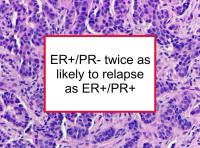Tumors that are estrogen receptor positive and progesterone receptor negative (ER+/PR-) are a distinct subset of breast cancer known to have relatively aggressive behavior despite. Such tumors are typically grade 2 or grade 3, have relatively high proliferation (often with Ki-67 > 30%) and greater DNA instability than ER+/PR+ tumors.
These factors contribute to lower survival among women with ER+/PR- disease than those with ER+/ER+ disease. Now a new study presented at the Thirty-Ninth Annual CTRC-AACR San Antonio Breast Cancer Symposium has reported that women with ER+/PR- disease have more than double the rate of relapse (including both locoregional and distant recurrence) as those with ER+/PR+ disease during the first five years after diagnosis.
Latest research finds PR- status worsens prognosis
The study referenced above was designed to investigate the association between negative progesterone receptor status and outcomes of ER+/HER2- breast cancer using data from Johns Hopkins University School of Medicine in Baltimore, MD. To conduct the study, the authors analyzed consecutive, early stage, unilateral (one breast only), HER2-, invasive breast cancers diagnosed during the period 2000 to 2011. Medical records were used to collect data concerning age at diagnosis, stage, tumor characteristics, and breast cancer recurrence. Tumors were classified as having ER+ or PR+ status as long as immunoreactive cells ≥1%. Early recurrence was defined as breast cancer relapse (locoregional or distant recurrence) taking place six months to five years after diagnosis; late recurrence was defined as taking place after five years. Study participants were followed for a median of 84 months.
The study included 1,933 patients, of whom 1,489 had ER+/PR+, 337 had triple negative, and 107 had ER+/PR- disease. Those with ER+/PR- tumors did not differ significantly from those with ER+/PR+ disease with respect to age or stage at diagnosis.
However, ER+/PR- tumors were more likely to be high grade (37.9% compared to 17.8% of ER+/PR+ cases) and had higher median Ki-67 (20.0% compared to 10.0%). ER expression also tended to be lower in cases of ER+/PR- disease (median of 80.0% compared 90.0%). A total of 119 early and 54 late relapses took place during follow up.
Negative PR was found to be strongly associated with early recurrence: ER+/PR- tumors were 2.1 times more likely to relapse during the first five years as ER+/PR+ tumors.
